Gertrude Jekyll Meets Edible Landscaping: The Ornamental Edible Border
admin March 3rd, 2011
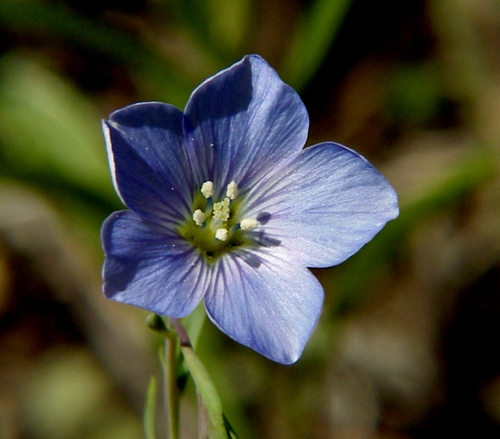
Ok, you know about edible landscaping - you’ve replaced your burning bush with blueberries and your spireas with elderberries. You’ve trained that grapevine over the arbor. Now you are eying that space on your front lawn where the perennial border is (or should be or used to be or is in your head). You want flowers. You need flowers because they make you happy. Maybe you have to grow flowers there if you grow much of anything but grass, because of neighbors or zoning laws. Can you grow an ornamental flower garden that is totally edible? Yes. Yes, you can!
I don’t just mean “edible flowers” which, after all, are very cool but not main crops. And I don’t mean something you might add a tiny taste of to your garden. I’m talking about food plants that are beautiful too. Consider it your stealth food garden - and consider it perfect for public places, where you are worried about someone nipping off with your cherry tomatoes or your carrots. Only the well informed will have the faintest idea that these are even food. There’s something magical and fun to me about the idea of a “secret garden” in plain sight.
I have two plans here for a garden of edible flowering plants, one for sun, one for shade. Obviously, if you live somewhere tropical or desertish, you’ll have to do your own planning, but for much of the temperate US from zone 7-4 certainly and probably into parts of 8 and 3, you could grow most of these plants. They are beautiful, they offer a long season of flower and foliage beauty, many are perennial (you can fill it in with annuals that I’ll suggest at the end) and they are tasty. What more could you want? My idea was to ask myself “If Gertrude Jekyll was planning an edible garden, what would it look like?”
First, a shady ornamental-edible garden - this will work best for light to moderate shade and reasonably moist conditions - very dry or very deep shade won’t work.
Ok, even I didn’t know until my awesome partner-in-crime Aaron Newton told me - Hostas are edible!!! I’ve never liked them much, but after I heard the shoots taste like slightly salted asparagus, well, I’m softening on them. So first, hostas! My research suggests that some varieties are tastier than others, but that not much research has been done on this - so here’s an opportunity to contribute useful and important knowledge!
Daylilies are a gorgeous and delicious edible plant/flower and will tolerate partial shade, although they do best in full sun (at the southern end of their range, they might actually prefer shade). The wild orange daylily will do well in part shade, as do several cultivated varieties, including “Orange Crush” and “Dallas Star.” One source I found suggested that dark-colored daylilies generally do better in shade. I have a Stella d’Oro that does well as well in moderate shade. Daylilies provide two seasons of food - the shoots are tasty fresh and are traditionally dried and used in hot and sour soup, called “golden needles.” The flowers are the best tasting edible flower out there and wonderful in salads.
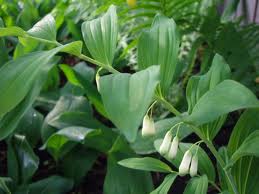
Giant Solomon’s Seal (polygonatum giganteum) is a gorgeous woodland native that offers spring to early summer white bell flowers. It will even take partial sun, but without enthusiasm. The shoots are edible (look like asparagus but taste more like artichokes) as are the tubers (good with butter, I’m told, but I haven’t tried them).
Orange Jewelweed -aka Spotted Touch Me Not. Ok, you aren’t going to get more than a tasty snack out of this - they aren’t really a calorie crop, but it is such a valuable plant it is worth it. Jewelweed seeds (you know, the ones that “pop,” which explains the other common name) taste exactly like walnuts - they are delicious. Very, very small - you won’t be making too many cookies with them, but yum. Plus, Jewelweed is the best anti-itch plant around - soothes poison oak and ivy, rashes of all kinds, etc… The leaves are weedy looking, I fear, but the flowers are gorgeous and orchid-like and well worth it.
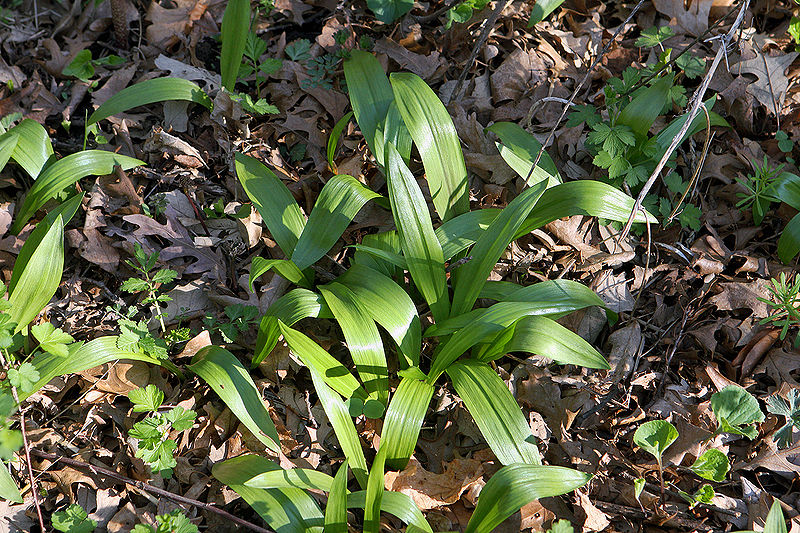
Ramps don’t really flower, but their strap-like foliage is pretty and pleasant all year round, and their flavor is spectacular - my kids beg for ramps. They do look a lot like lily-of-the-valley, so don’t plant them anywhere near the latter, since lily of the valley is quite poisonous.
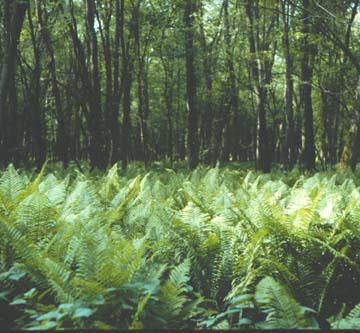
Ostrich Fern - the ideal source of fiddleheads. A delicious and beautiful crop, you get your spring delicacy with ferny beauty put together.
.jpg)
Jerusalem artichokes will tolerate quite a lot of shade, and indeed, are less aggressive that way. They provide delicious tubers that are really wonderful, and provide bright late season color. The only important thing is to keep them from overpowering everything else.
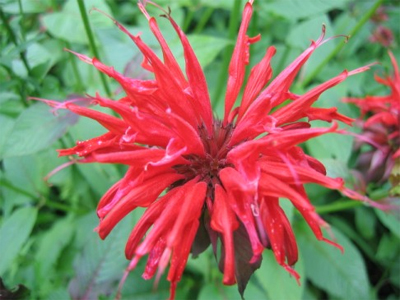
Bee Balm is another possibility - it will probably do well in partial shade. It is prone to mildew in shade, but it is an excellent tea plant and the bright red, pink or purple can light up a border. The flowers are also edible.
Finally, let’s anchor our planting with a couple of shrubs - two beautiful black elderberries, providing flowers in the spring and fruit in the autumn, and a black currant, whose leaves can be used to crisp and give a smoky flavor to pickles, while their delicious fruit makes jam, wine or juice. Or if you prefer, red or white currants. All will tolerate partial shade, all are extremely ornamental and tasty!
If you live in a warmer zone, you can probably also grow taro (elephant ears) and additional plants. Pansies and Johnny-jump ups are good annuals for shade to fill in any weak spaces and add more color - the flowers are delicious in salads - they will provide color all season long in the cooler regions and spring and fall color in warm places. Tuberous begonias have edible, slightly tart-crisp flowers and do well in shade as well.
Ok, now a sunny perennial border with a few annuals thrown in for good luck!
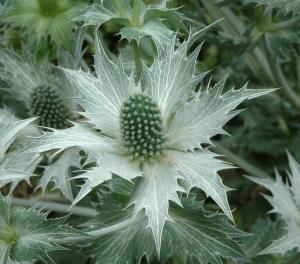
As much as I really don’t like hostas (a prejudice I’m getting over) I *love* sea hollies - they are a favorite plant of mine. The roots, roasted, really do taste like chestnuts. They were once upon a time candied and served as aphrodisiac desserts. I’ve not tried the latter ![]() . The shoots can be blanched, the leaves are edible and tasty, and they are weird but stunningly beautiful, and come in the rarest of all colors, blue. What’s not to love?
. The shoots can be blanched, the leaves are edible and tasty, and they are weird but stunningly beautiful, and come in the rarest of all colors, blue. What’s not to love?
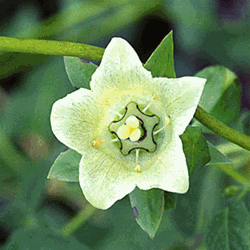
Sweet and spicy Codonopsis roots are a delicacy, served in korean style barbecue sauce or used to give a spicy-sweet taste to rice, or added to soups. It is also known as Dang Shen or “poor man’s ginseng” although the compounds in it are not the same as in ginseng. They are an important medicinal also used as food in much of Asia. It does need something to climb on, and the roots usually take several years to mature, but are well worth the wait. In the meantime, the plant is gorgeously ornamental. In the warmer parts of its range, it will take part shade, and it will take light shade even in more northerly spots, so it could be part of the garden above as well!
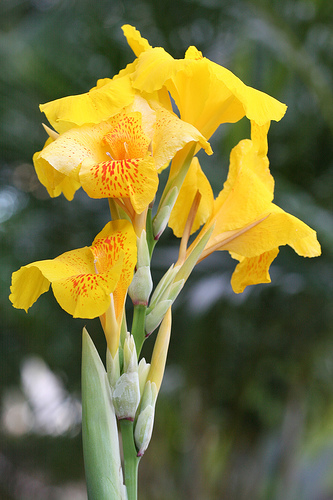
I credit Eric Toensmeier’s _Perennial Vegetables_ for pointing out that ornamental cannas are actually edible. In our range, the tubers have to be lifted and stored over the winter, but that’s a small price to pay for something so delicious and so beautiful. Canna starch is used to make cellophane noodles used Vietnamese and other Asian cuisines, and Canna production for starch is a major Vietnamese agricultural product. Canna tubers do need to be roasted for a long time, but come out meltingly sweet and carmelized and very delicious.
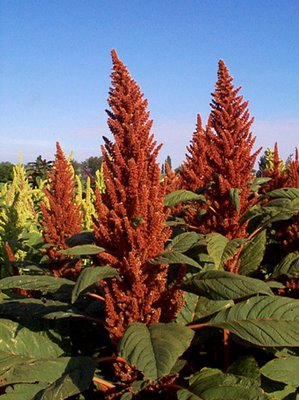
Daylilies would be another great addition to this, and you could add Jerusalem artichokes or Maximillian Sunflowers, or just use annual sunflowers at the back of the border to add height and drama. As long as we’re talking about drama and height, annual amaranths come in a wide range of stunning colors, produce edible grain, young salad leaves and cooking greens. They are the perfect ornamental edible.
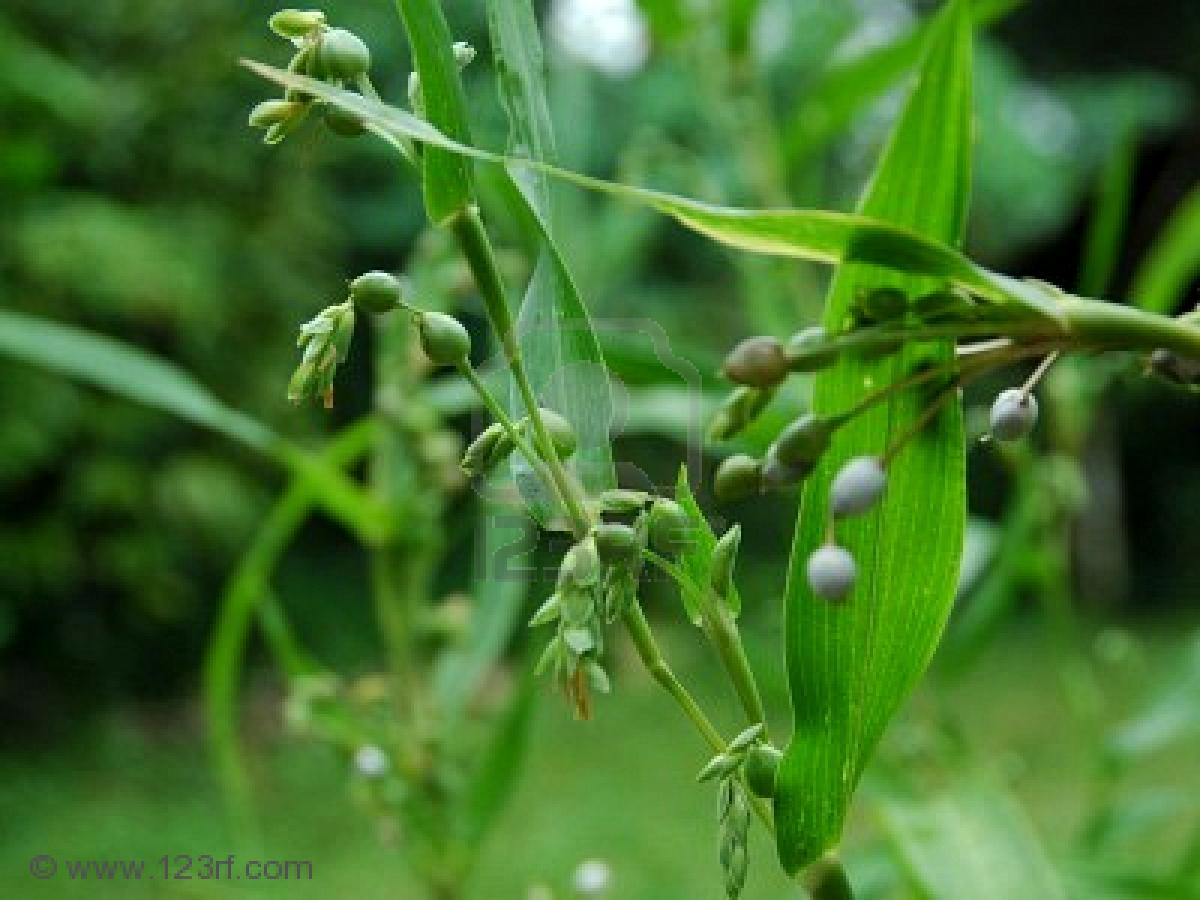
In the grain department, what about Job’s tears? It is perennial tropical grass, grown as an ornamental annual here - and it is lovely stuff. Moreover, the seeds can be eaten as a porridge, ground to make a nutritious drink, or for that matter, laquered and used as jewelry - they have a natural hole that lends itself to stringing. It doesn’t overwinter, but the tufts of grass are pretty if left standing in the winter garden as well.
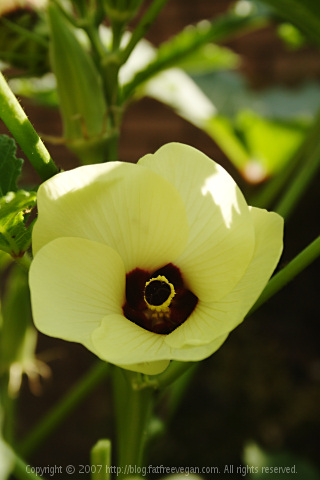
I admit, I simply don’t grasp why everyone doesn’t grow okra in the north - it just isn’t that hard. Somehow, okra and sweet potatoes (another fave) have the perception of being southern crops - but I get good harvests of both her in zone 4. Okra is certainly purty enough to make it into the border. Other more common vegetables worth including in the sunny border are eggplant, ornamental hot peppers, edible chrysanthemum, and “Red Russian” and “Bright Lights” Chard.
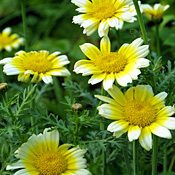
(Shunkgiku, or edible Chrysanthemum)
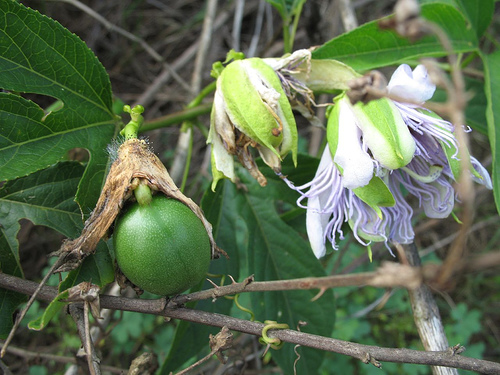
As fruiting things go, Maypop is sort of borderline in the northerly parts of our range, and it can be invasive in the most southerly ones, but there is a happy medium, and I’ve successfully managed to nurture one along in a sheltered spot and get a few passionfruits every year - worth the effort. The stunning flowers are worth a lot too!
There are certainly no shortage of ornamental shrubs out there to anchor your border - I’m sure you can think of a bunch. I won’t bore you with blueberries, however - what are some of the unusual ornamental edibles you could grow?
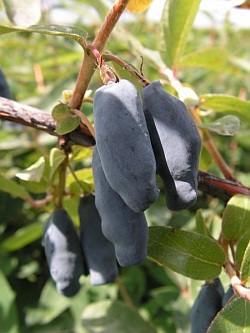
Honeyberry is pretty - it is a honeysuckle and has lovely, very early flowers an is the first fruiting shrub in my garden. The berries are good - its only major flaw is that it drops its leaves early in the season, but I’ve heard you can stave this off by fertilizing late. The provide such beautiful early flowers and fruit, however, this seems a small price to pay.
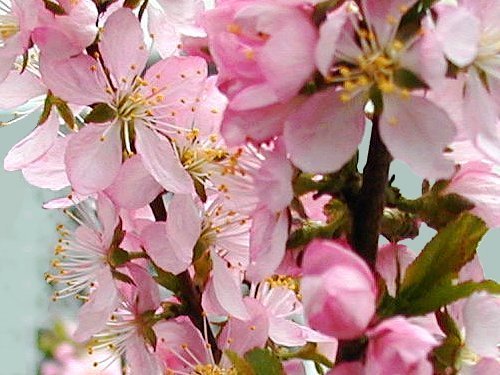
Bush cherries are just plain stunning in the landscape - well worth it. The fruit is ok straight, but excellent in jams and syrups, and my one experiment with it suggests it makes terrific wine.
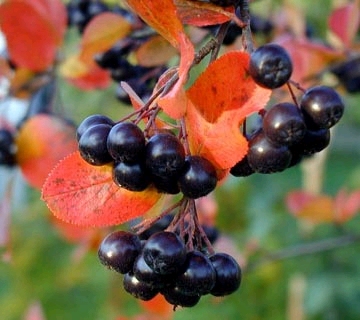
Aronia is my other recommendation - the bright, fiery fall color would make it worth it alone, but the berries are terrific, highly nutritious and the whole thing is the easiest plant out there - put it in a hole and forget about it.
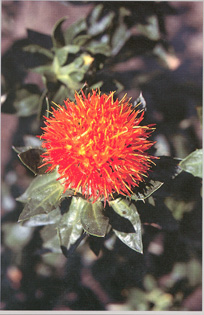
If we need to fill in spots in the border with bright annual color, certainly, let’s throw in some nasturtiums which obviously add color, delicious flowers, tasty leaves and best of all, seed pods that taste like capers when pickled. Or how about safflower blossoms, to add to salads and to color our rice without spending bazillions on saffron. For that matter, you could add autumn color by growing saffron crocuses (not annual). What about flax for edible seeds? And a tuteur or trellis covered with Hyacinth beans and/or scarlet runner beans.
See, Gertie, told you I could do it! I’m hoping, btw, that we will be able to offer many of these plants, if not all, in our plant CSA and herb nursery - more information on that coming up ASAP!
Sharon
- garden , garden design
- Comments(21)
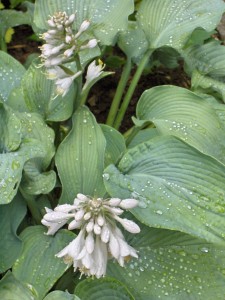
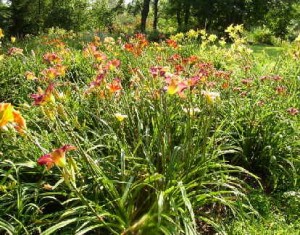
I’ve been thinking about Aronia! This year, orchard. Next year, sneaky hidden edibles.
Bush cherries make a wonderful wine. We made wine out of our crop last year. Even before aging it was delicious, and by this summer it will be ready to drink and even more delicious. The year before last, we tinctured the cherries in grain alcohol to make an excellent cherry liquor. Robins love bush cherries so I have to mass-harvest them fast before the robins realize they are ready. We got about 9 pounds of cherries out of our three shrubs last year.
This could have been written by someone familiar with our little acre. This is a great affirmation, Sharon, thanks! I keep hiding the delicious, edible, medicinal goodies in plain sight! I did not know about the edibility of hostas, so thanks!
(I’m going through an exclamatory phase. Please bear with me.)
Absolutely love the photos!
Daylily leaves (when they first come up, at least) taste like the best lettuce ever. I’m amazed that more people don’t know about them. And they grow like weeds.
I’ve never heard of hyacinth beans before … I’m going to have to get some of those and try them out.
My most favorite post! How did you know this is the exact issue I’m trying to work through for my recently de-nuded partial sun-flower boxes that happen to sit 3 feet off the road?
Thank you for all the wonderful suggestions (and I’ll also be kinder to the humble hosta now).
-Nicole
Great article, Sharon. Hosta? Who knew? Don’t forget the pyracantha that is good for jelly or wine and canna (not to eat) which will filter water. The list is practically endless, right? It’s just a matter of learning and observing. I learned alot from you today.
Another useful ornamental is Tigridia, which ought to grow in your climate, although I expect the bulbs would need lifting. They are spectacular. I just posted about it.
I meant to say - if possible get the variety of Job’s tears known as Ma-yuen. It has softer hulls which are usually brown rather than grey and is the one normally used for food.
I’d like to add a plant that could go into sun or partial shade and that’s evening primrose. It’s biennial, but the ones in our garden have self-seeded since forever. They’re flowers are very good and they flower most of the summer. I rarely go into the garden now without eating a few.
As for hostas, I’ve been trying to acquire a taste for them (literally), but repeated exposure seems to be having the opposite effect. I like them less now than the first time I tried them. Maybe we don’t have the right varieties.
Hyacinth beans are great because they produce so many pods per plant, in a radial pattern. The pods aren’t that big, though, and they are kind of tough if you want to eat the pods rather than waiting for the beans. They also are very cold hardy when the season’s ending.
Runner beans would be great if they didn’t have a habit of dropping flowers and not producing pods until late in the season. Total yields for me consistently stink because of this. They seem very temperature sensitive during the summer. This is probably why they are primarily used as ornamentals. Might be great in a colder climate (I’m in zone 6).
Thanks so much, Sharon! Love this post, and with photos, too!
One thing I’m not sure about: Solomon’s Seal is used as an herbal medicine and is cautioned against in some references. Cooking and eating the tubers may be different enough from a tincture to not be risky, but diabetics probably should research it.
“How does Solomon’s Seal work?
Solomon’s seal contains chemicals that might decrease blood sugar levels.
Are there safety concerns?
Solomon’s seal is safe for most adults when taken for short time periods. It can cause some side effects such as diarrhea, stomach complaints, and nausea when taken for long time periods or in large doses.
Do not use Solomon’s seal if:
* You are pregnant or breast-feeding.
* You have diabetes.
* You are scheduled for surgery in the next two weeks. ”
http://www.rxlist.com/script/main/art.asp?articlekey=96168&page=2
Hello. We’re looking forward to replacing some of our inedible decorative plants with “dual purpose” plantings, ie, the hedge out front is going to get replaced with something like high-bush blueberries: an edible barrier.
For those of you like us who wage a constant battle against Japanese Knotweed (the stuff that looks like bamboo, but isn’t and is almost impossible to kill), you might consider acquiring a taste for the shoots. We’ve done a bit of experimentation, and discovered them to be edible. It’s like lemony asparagus. However, there is a texture issue we can’t quite get past: after steaming, the shoots emit a slimy juice. Eww!
Has anyone else experimented with this stuff? I would never plant it, but it’s very invasive, and it just HAS to be good for something.
Tad and Ellen
South Portland, Maine
Add the usual cautions when propagating/spreading/harvesting plants
Jewelweed can quickly become invasive
while others are quite slow to regenerate - ferns, ramps. Unless you grow your own and take only as much as you put back harvesting these species can be quite destructive.
Dang. I smell a book here! I could really use a little pocket guide on this subject. I’m woefully ignorant and I grow most of it. I just don’t use for anything but feeding my soul.
ET, I have something of a problem with the definition of Jewelweed as “invasive” - it isn’t invasive in any true sense, although it can be a pest. As a native plant, it is not a true invasive, even though it is a common weed. Yes, you have to control it - but that’s true of mints, bamboo, and any number of other plants. I find jewelweed to be fairly well behaved here, honestly. But I do take your point - it is listed as a noxious weed in the Pacific NW.
Neither fiddlehead nor ramp harvesting needs to harm the extant population - as long as you don’t take the roots. Taking the first spring flush results in both plants in replacement growth in my observation. We’ve been harvesting both (the ostrich fern from plants established by previous owners, the ramps established by me) and we’ve seen increases, not decreases in plant populations. I have seen ramps sold with the whole root on, though, rather than just the top foliage, so I take your point. I’ve never seen fiddleheads sold that way, but I can imagine that if you were harvesting them two or three times it would diminish populations. We only cut once.
Sharon
I’m glad to see you mention okra. I grow it in Maine with no problems, and they have such gorgeous flowers.
Is it possible to know some recipes with these beautiful vegetables/flowers ? Thank you !
Robert Henderson’s “The Neighborhood Forager” is great for ornamental ideas and recipes. He also approaches the edible landscaping idea from the ornamental direction first, instead of sorting through edibles for pretty things.
I use garden sorrel in my front yard flowerbeds as a luminous foliage backdrop. My favorite stealth edible is the linden tree - hardy to zone 3, delicious young leaves ready way before lettuce, and flowers that can be brewed into a relaxing tea.
I’m only just beginning to become familiar with edible landscaping, and I’ll have to look into some of your suggestions, above! Thanks!
One note about bee balm: I bought a bee balm plant from the store with the intention of making a bergamot-flavoured tea. However, the tea I wound up with tasted decidedly more like oregano, which initially concerned me because I thought perhaps the plant ID had been wrong (it didn’t flower that year, so I couldn’t verify by bloom). So I looked it up and apparently different soil types and different regions will wind up with different tasting bee balm. People in the SW use it as an oregano substitute, which is what I also do now (I’m in Alabama, zone 8). It’s quite prolific and I love oregano, so what a boon! Just thought I’d mention this in case people who read your blog try to grow it and it winds up with an unexpected flavour for tea.
Kristina, that’s interesting - I hadn’t heard that different soils make such a difference. It is also worth noting that not all bee balms taste alike - the bergamot version is a specific variety, as is the lemon one. Different varieties have different flavors.
Sharon
[...] Yard_ by Ivette Soler that The Peak Oil Hausfrau has just reviewed. I did a post a while back on ornamental perennial edibles, and I wanted to do a companion piece on ornamental medicinal herbs. If you are looking for [...]